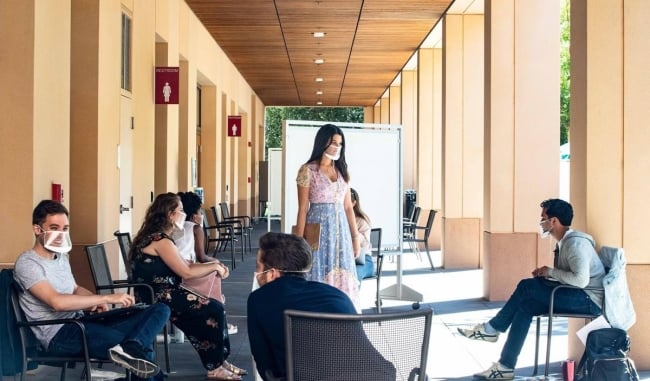You have /5 articles left.
Sign up for a free account or log in.

Stanford business school
Stanford University's M.B.A. class is among the top ranked in the world, and also among the more expensive. Tuition alone is $74,706. The business school estimates total annual costs of a full-time student at $118,644.
Stanford relies on international students, who are scarce at many U.S. colleges, creating another obstacle.
How, then, did Stanford diversify its M.B.A. class -- significantly -- this year?
Stanford's full-time M.B.A. program is meeting in Palo Alto, Calif., with many classes in person.
But first-year students are from 66 countries, with international students making up 35 percent of the class.
Women account for 47 percent of the class, up from 41 percent a few years ago.
U.S. students of color comprise 37 percent of the total class, up from 27 percent last year. They make up 47 percent of class members who are U.S. citizens and permanent residents. Stanford has historically released data on how many students of color it admits in total, but for the first time ever last week, it released data on how many Black, Latinx, Asian American and Native American students were admitted (both under federal guidelines and under the system for reporting dual identities. Under the federal criteria, Asian Americans are the largest nonwhite group, with 23 percent of students. Latinx students are 11 percent of the total, and Black enrollment is 7 percent).
Nine percent of students are the first in their families to attend a college.
And the total size of Stanford's first-year M.B.A. class is 436, up from 420.
All of which raises the question: What did Stanford do that was different from years past?
Nationally, many top M.B.A. programs are experiencing a surge in applications after several years of declines. Those who can afford it consider an M.B.A. from a top program a good investment at a time when the economy is suffering. But the increases are not necessarily resulting in more diverse student bodies. And many M.B.A. programs that are not highly competitive in admissions are having a tough year in admissions, as has been the case for several years now.
Kirsten Moss, assistant dean of the Stanford M.B.A. program for admissions, said that releasing more information about students was being talked about well before the COVID-19 pandemic. But she said the pandemic -- and the Black Lives Matter movement that grew with the killing of George Floyd -- encouraged it. She characterized it as a move toward "transparency" more than anything else.
Moss has been in admissions for 20 years, and she said the demands for more transparency have never been stronger.
Wil Torres, assistant director of outreach and diversity, said the programs that seem most successful in attracting diverse applicants are reflections of Stanford's strengths. A program called Diversity in Leadership, for instance, is among the most popular (although it had to be rejiggered this year to be virtual).
Moss said it's not that Stanford started new programs this year only. "It took years of work," she said.
On the other hand, there are very specific challenges at Stanford. The business school has surveyed students who consider getting an M.B.A. and don't (or don't get one at Stanford), and the top reason is money. "They say it's cost, and that if they had the financial aid they would come," she said.
So Stanford created Building Opportunities for Leadership Diversity (BOLD) to provide fellowships of up to $80,000 over two years. The awards are based on need, but because Stanford typically admits those who have been working for a few years, they factor in family support. So if a prospective student would need child support to attend class, that could be considered.
Alumni support makes these fellowships possible, Moss said. This year, an alumnus endowed a scholarship under which anyone from Latin America with income of less than $40,000 could apply for free.
Moss said that recruiting international students has been a challenge this year, with visa problems and the pandemic encouraging some students to stay home. Still, the share of the class that is international fell only to 35 percent (from 40).
Stanford let all international students defer for a year, or take classes online, if visa issues kept the students from campus.
To recruit women, Stanford has a program in which female students host coffees (this year virtually) for between eight and 10 prospective students. More than 200 such coffees are held a year.
Josh Frank Payne is a first-year M.B.A. student who applied only to Stanford. "I felt that for what I wanted to do, tech and entrepreneurship, Stanford was the only place that would add value for me personally." He is also working on an M.S. in computer science.
His love of computer science didn't come easily. "I didn't do well in my first CS classes, having had no background, but I persisted."
He decided to apply to the M.B.A. program for two reasons. "First, when I was in my first year at Stanford during undergrad, I took two classes at the Graduate School of Business as I was working on a venture of my own and I had the opportunity to work with several GSB students on these projects. I was blown away by how incredible the program [was], and the people I met had had a lasting impact on me. Second, in the summer before my senior year in undergrad, I was working on a venture in which one of my co-founders was a professor at the UC Riverside business school. Knowing how interested I was in initiating and growing ventures with technology, he encouraged me to apply and offered to write a letter of recommendation for me. I matriculated to the GSB following my graduation."
The double degree is a trend among students. Andrew Loh is from Malaysia, a graduate of Swarthmore College, and is also earning a master's degree at Harvard University Kennedy School of Government.
This summer, he co-founded an online platform to help Malaysia better use the COVID-19 aid it was receiving. The site quickly gained 300,000-plus users -- and the backing of the U.S. Agency for International Development.
"I was attracted to Stanford's unique focus on impact beyond the business world. GSB's tagline -- 'change lives, change organizations, change the world' -- particularly resonated with me as I wanted to be inspired and challenged by classmates who wanted to have impact beyond themselves."








